Impregnation of Activated Carbon with Organic Phase-Change Material
Abstract
:1. Introduction
2. Materials and Methods
2.1. Materials
2.2. Method of Filling Activated Carbon with Organic PCM
2.3. Temperature Measurement Devices
2.4. Analytical Instrumentation
3. Results and Discussion
3.1. Measurement and Prediction of Latent Heat for Activated Carbon/PCM Mixtures
3.2. Dynamic Model of Activated Carbon/PCM Mixture
3.3. Characteristics of Activated Carbon before and after Organic PCM Filling
3.4. Thermal Absorption and Release of Alkane PCM Embedded in Activated Carbon
3.5. Thermal Stability of Activated Carbon Filled with PCM
3.6. Reproducibility of Low-Temperature PCM Characteristics after Long-Term Exposure to High Temperatures
3.7. Thermodynamic Analysis
4. Conclusions
Author Contributions
Funding
Institutional Review Board Statement
Informed Consent Statement
Data Availability Statement
Conflicts of Interest
References
- Salkuti, S.R. Emerging and advanced green energy technologies for sustainable and resilient future grid. Energies 2022, 15, 6667. [Google Scholar] [CrossRef]
- Poudyal, R.; Loskot, P.; Nepal, R.; Parajuli, R.; Khadka, S.K. Mitigating the current energy crisis in Nepal with renewable energy sources. Renew. Sustain. Energy Rev. 2019, 116, 109388. [Google Scholar] [CrossRef]
- Zahraoui, Y.; Khan, M.R.B.; AlHamrouni, I.; Mekhilef, S.; Ahmed, M. Correction: Zahraoui et al. Current Status, Scenario, and Prospective of Renewable Energy in Algeria: A Review. Energies 2021, 14, 2354. [Google Scholar] [CrossRef]
- Olabi, A.; Abdelkareem, M.A. Renewable energy and climate change. Renew. Sustain. Energy Rev. 2022, 158, 112111. [Google Scholar] [CrossRef]
- Akram, M.W.; Mohd Zublie, M.F.; Hasanuzzaman, M.; Rahim, N.A. Global prospects, advance technologies and policies of energy-saving and sustainable building systems: A review. Sustainability 2022, 14, 1316. [Google Scholar] [CrossRef]
- Allan, G.; Eromenko, I.; Gilmartin, M.; Kockar, I.; McGregor, P. The economics of distributed energy generation: A literature review. Renew. Sustain. Energy Rev. 2015, 42, 543–556. [Google Scholar] [CrossRef]
- Rashid, F.L.; Al-Obaidi, M.A.; Dulaimi, A.; Mahmood, D.M.; Sopian, K. A Review of Recent Improvements, Developments, and Effects of Using Phase-Change Materials in Buildings to Store Thermal Energy. Designs 2023, 7, 90. [Google Scholar] [CrossRef]
- Lawag, R.A.; Ali, H.M. Phase change materials for thermal management and energy storage: A review. J. Energy Storage 2022, 55, 105602. [Google Scholar] [CrossRef]
- Zhang, Y.; Li, W.; Huang, J.; Cao, M.; Du, G. Expanded graphite/paraffin/silicone rubber as high temperature form-stabilized phase change materials for thermal energy storage and thermal interface materials. Materials 2020, 13, 894. [Google Scholar] [CrossRef]
- Ma, C.; Zhang, Y.; Chen, X.; Song, X.; Tang, K. Experimental study of an enhanced phase change material of paraffin/expanded graphite/nano-metal particles for a personal cooling system. Materials 2020, 13, 980. [Google Scholar] [CrossRef]
- Mishra, R.K.; Verma, K.; Mishra, V.; Chaudhary, B. A review on carbon-based phase change materials for thermal energy storage. J. Energy Storage 2022, 50, 104166. [Google Scholar] [CrossRef]
- Kabeel, A.; Abdelgaied, M. Improving the performance of solar still by using PCM as a thermal storage medium under Egyptian conditions. Desalination 2016, 383, 22–28. [Google Scholar] [CrossRef]
- Xu, H.; Wang, Y.; Han, X. Analytical considerations of thermal storage and interface evolution of a PCM with/without porous media. Int. J. Numer. Methods Heat Fluid Flow 2020, 30, 373–400. [Google Scholar] [CrossRef]
- Souayfane, F.; Fardoun, F.; Biwole, P.-H. Phase change materials (PCM) for cooling applications in buildings: A review. Energy Build. 2016, 129, 396–431. [Google Scholar] [CrossRef]
- Jaguemont, J.; Omar, N.; Van den Bossche, P.; Mierlo, J. Phase-change materials (PCM) for automotive applications: A review. Appl. Therm. Eng. 2018, 132, 308–320. [Google Scholar] [CrossRef]
- Oró, E.; De Gracia, A.; Castell, A.; Farid, M.M.; Cabeza, L.F. Review on phase change materials (PCMs) for cold thermal energy storage applications. Appl. Energy 2012, 99, 513–533. [Google Scholar] [CrossRef]
- Dhanusiya, G.; Ashwani, K. Evaluation of the impact of different composite phase change materials on reduction in temperature and enhancement of solar panel efficiency. J. Energy Storage 2023, 60, 106631. [Google Scholar]
- Dwivedi, V.K.; Tiwari, P.; Tiwari, S. Importance of Phase Change Material (PCM) in solar thermal applications: A review. In Proceedings of the International Conference on Emerging Trends in Electrical Electronics & Sustainable Energy Systems, Sultanpur, India, 11–12 March 2016; pp. 42–45. [Google Scholar]
- Salunkhe, P.B.; Shembekar, P.S. A review on effect of phase change material encapsulation on the thermal performance of a system. Renew. Sustain. Energy Rev. 2012, 16, 5603–5616. [Google Scholar] [CrossRef]
- Höhlein, S.; König-Haagen, A.; Brüggemann, D. Macro-encapsulation of inorganic phase-change materials (PCM) in metal capsules. Materials 2018, 11, 1752. [Google Scholar] [CrossRef]
- Shirin-Abadi, A.R.; Mahdavian, A.R.; Khoee, S. New approach for the elucidation of PCM nanocapsules through miniemulsion polymerization with an acrylic shell. Macromolecules 2011, 44, 7405–7414. [Google Scholar] [CrossRef]
- Izadi, M.; Taghavi, S.F.; Safavi, S.H.N.; Afsharpanah, F.; Yaïci, W. Thermal management of shelter building walls by PCM macro-encapsulation in commercial hollow bricks. Case Stud. Therm. Eng. 2023, 47, 103081. [Google Scholar] [CrossRef]
- Hu, C.; Sha, L.; Huang, C.; Luo, W.; Li, B.; Huang, H.; Xu, C.; Zhang, K. Phase change materials in food: Phase change temperature, environmental friendliness, and systematization. Trends Food Sci. Technol. 2023, 140, 104167. [Google Scholar] [CrossRef]
- Jin, X.; Haider, M.Z.; Ahn, J.; Fang, G.; Hu, J.W. Development of nanomodified eco-friendly thermal energy storing cementitious composite using PCM microencapsulated in biosourced encapsulation shell. Case Stud. Constr. Mater. 2023, 19, e02447. [Google Scholar] [CrossRef]
- Chibani, A.; Mecheri, G.; Merouani, S.; Dehane, A. Hydrogen charging in AX21 activated carbon-PCM-metal foam-based industrial-scale reactor: Numerical analysis. Int. J. Hydrogen Energy 2023, 48, 32025–32038. [Google Scholar] [CrossRef]
- Banu, D.; Feldman, D.; Hawes, D. Evaluation of thermal storage as latent heat in phase change material wallboard by differential scanning calorimetry and large scale thermal testing. Thermochim. Acta 1998, 317, 39–45. [Google Scholar] [CrossRef]
- Sheik, M.A.; Aravindan, M.; Beemkumar, N.; Chaurasiya, P.K.; Dhanraj, J.A. Enhancement of heat transfer in PEG 1000 using nano-phase change material for thermal energy storage. Arab. J. Sci. Eng. 2022, 47, 15899–15913. [Google Scholar] [CrossRef]
- Chen, Z.; Shan, F.; Cao, L.; Fang, G. Synthesis and thermal properties of shape-stabilized lauric acid/activated carbon composites as phase change materials for thermal energy storage. Sol. Energy Mater. Sol. Cells 2012, 102, 131–136. [Google Scholar] [CrossRef]
- Khadiran, T.; Hussein, M.Z.; Zainal, Z.; Rusli, R. Shape-stabilised n-octadecane/activated carbon nanocomposite phase change material for thermal energy storage. J. Taiwan Inst. Chem. Eng. 2015, 55, 189–197. [Google Scholar] [CrossRef]
- Hekimoğlu, G.; Sarı, A.; Önal, Y.; Gencel, O.; Tyagi, V.; Aslan, E. Utilization of waste apricot kernel shell derived-activated carbon as carrier framework for effective shape-stabilization and thermal conductivity enhancement of organic phase change materials used for thermal energy storage. Powder Technol. 2022, 401, 117291. [Google Scholar] [CrossRef]
- Merritt, B.; Seneca, M.; Larson, S.; Davis, K.; Munro, T. Measurements of the thermal conductivity of reference liquids using a modified transient hot-wire needle probe. Int. J. Heat Mass Transf. 2022, 189, 122674. [Google Scholar] [CrossRef]
- Mishra, S.; Talukdar, P.; Trimis, D.; Durst, F. Two-dimensional transient conduction and radiation heat transfer with temperature dependent thermal conductivity. Int. Commun. Heat Mass Transf. 2005, 32, 305–314. [Google Scholar] [CrossRef]
- Menard, D.; Py, X.; Mazet, N. Activated carbon monolith of high thermal conductivity for adsorption processes improvement: Part A: Adsorption step. Chem. Eng. Process. Process Intensif. 2005, 44, 1029–1038. [Google Scholar] [CrossRef]
- Harder, A. Thermal Conductivity and Permeability of Activated Carbon with Variance in Sample Porosity. Master’s Thesis, North Carolina State University, Raleigh, NC, USA, 2010. [Google Scholar]
- Baek, S.; Ghaffari, Y.; Bae, J.; Kim, K.S. Development of Inorganic Impregnated Phase Change Material(PCM) in the Pores of Activated Carbon. J. Korean Soc. Environ. Eng 2021, 43, 709–718. [Google Scholar] [CrossRef]
- Wang, C.; Feng, L.; Li, W.; Zheng, J.; Tian, W.; Li, X. Shape-stabilized phase change materials based on polyethylene glycol/porous carbon composite: The influence of the pore structure of the carbon materials. Sol. Energy Mater. Sol. Cells 2012, 105, 21–26. [Google Scholar] [CrossRef]
- Li, B.; Liu, T.; Hu, L.; Wang, Y.; Nie, S. Facile preparation and adjustable thermal property of stearic acid–graphene oxide composite as shape-stabilized phase change material. Chem. Eng. J. 2013, 215, 819–826. [Google Scholar] [CrossRef]
- Ling, Z.; Chen, J.; Fang, X.; Zhang, Z.; Xu, T.; Gao, X.; Wang, S. Experimental and numerical investigation of the application of phase change materials in a simulative power batteries thermal management system. Appl. Energy 2014, 121, 104–113. [Google Scholar] [CrossRef]
- Verma, P.; Singal, S.K. Review of mathematical modeling on latent heat thermal energy storage systems using phase-change material. Renew. Sustain. Energy Rev. 2008, 12, 999–1031. [Google Scholar] [CrossRef]
- Pielichowska, K.; Pielichowski, K. Phase change materials for thermal energy storage. Prog. Mater. Sci. 2014, 65, 67–123. [Google Scholar] [CrossRef]
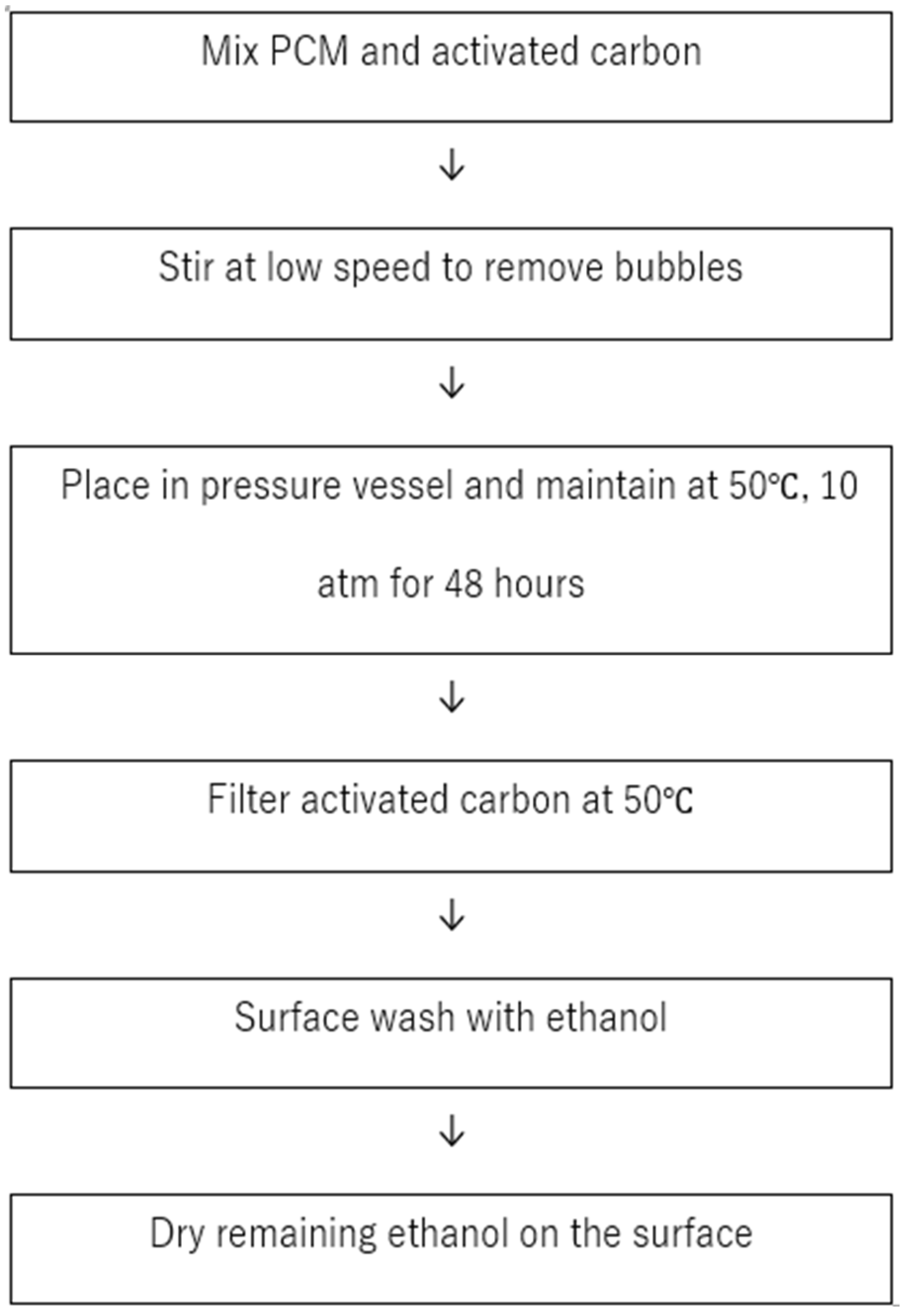
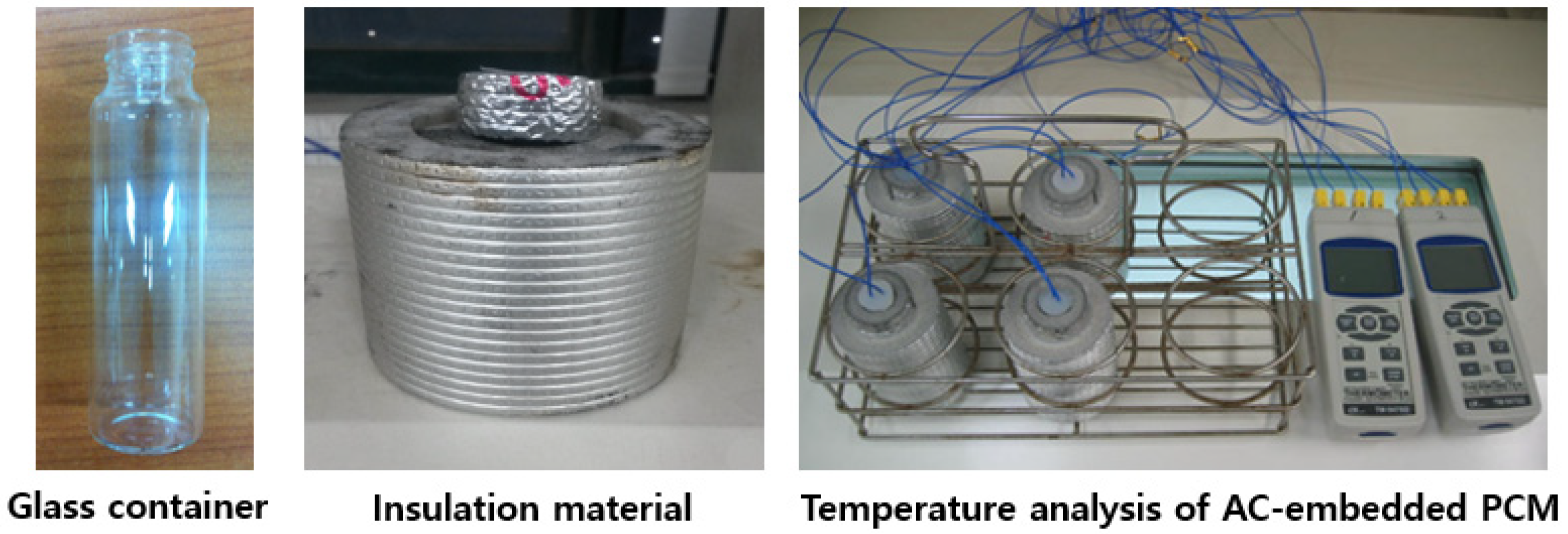
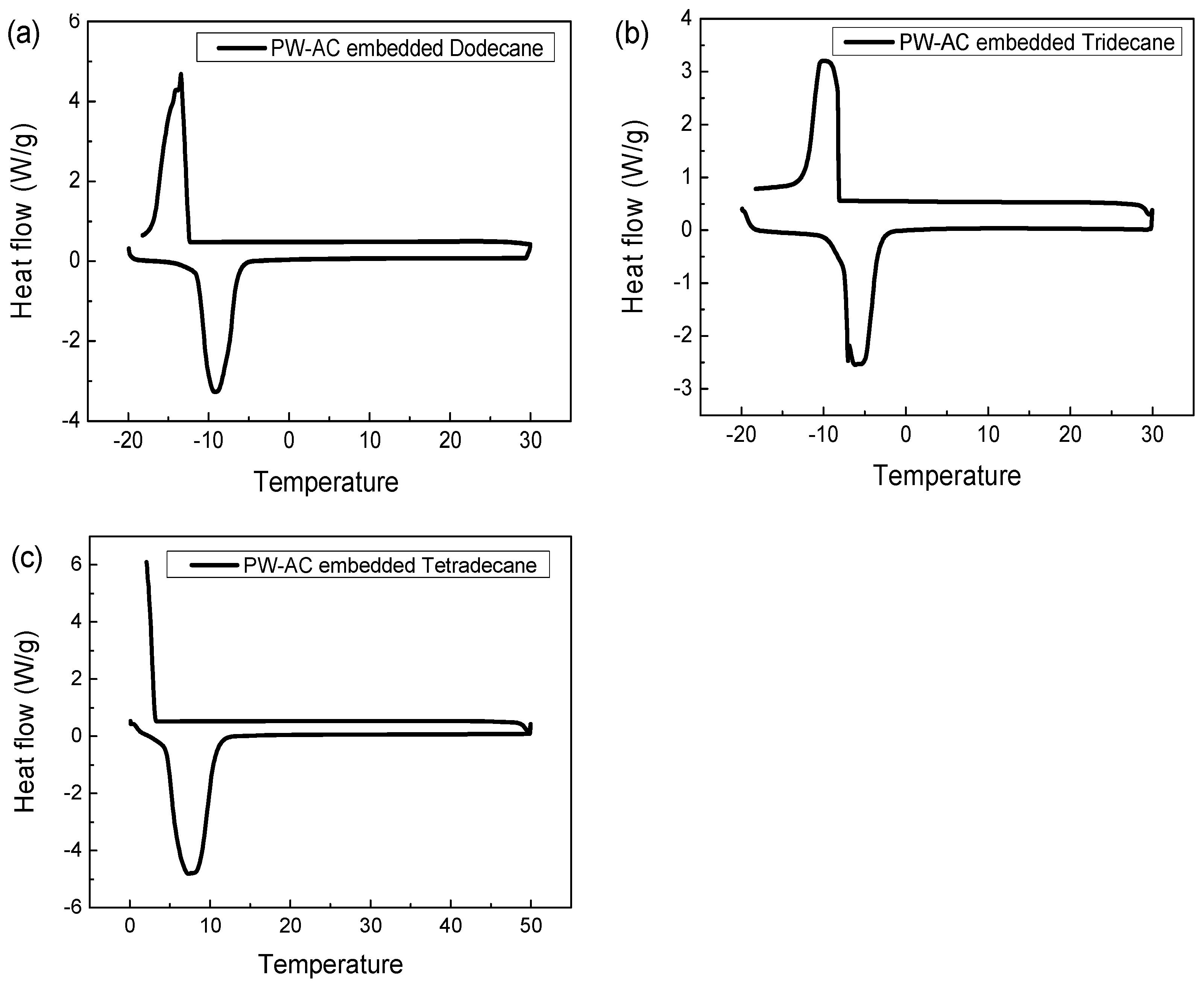

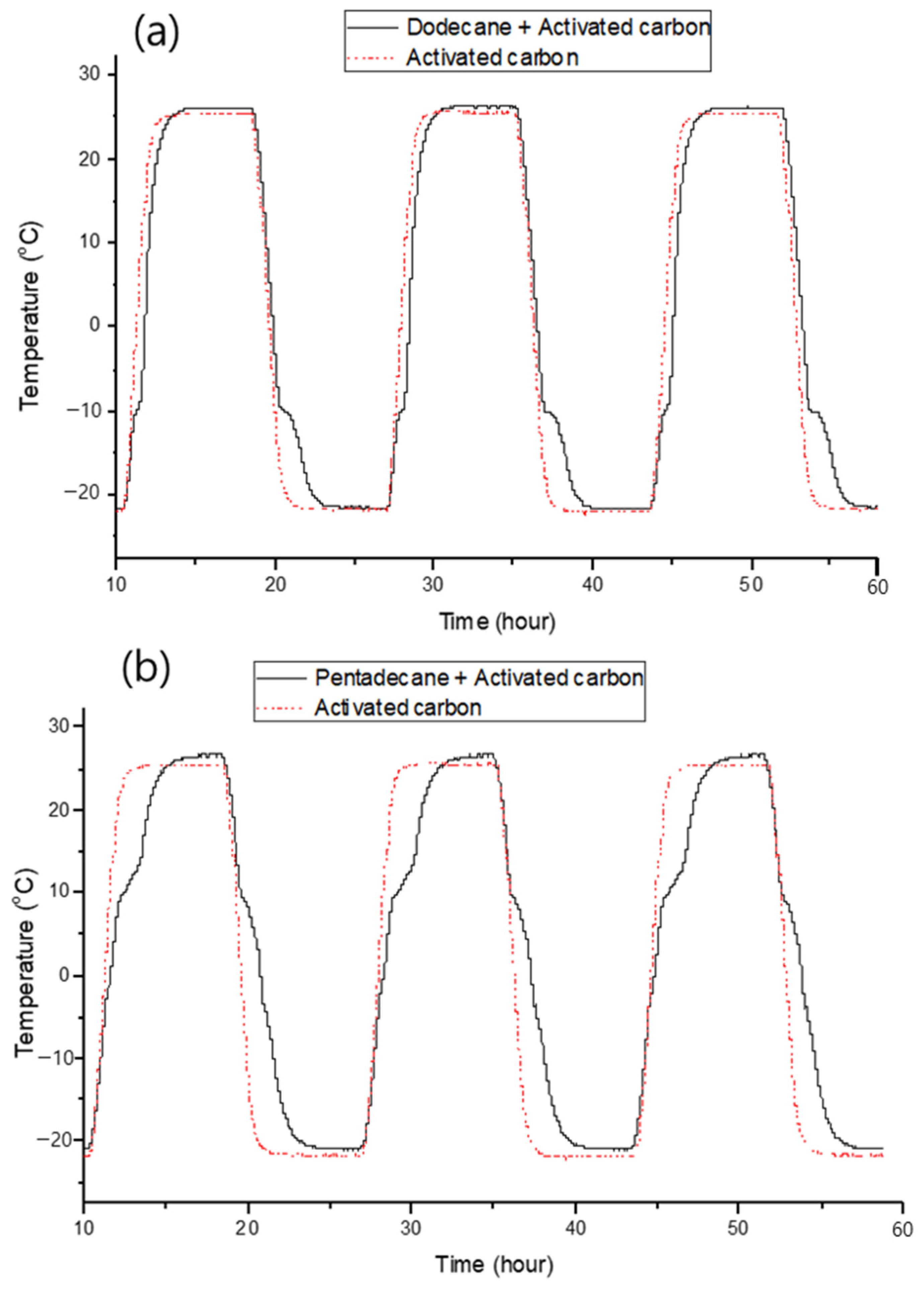
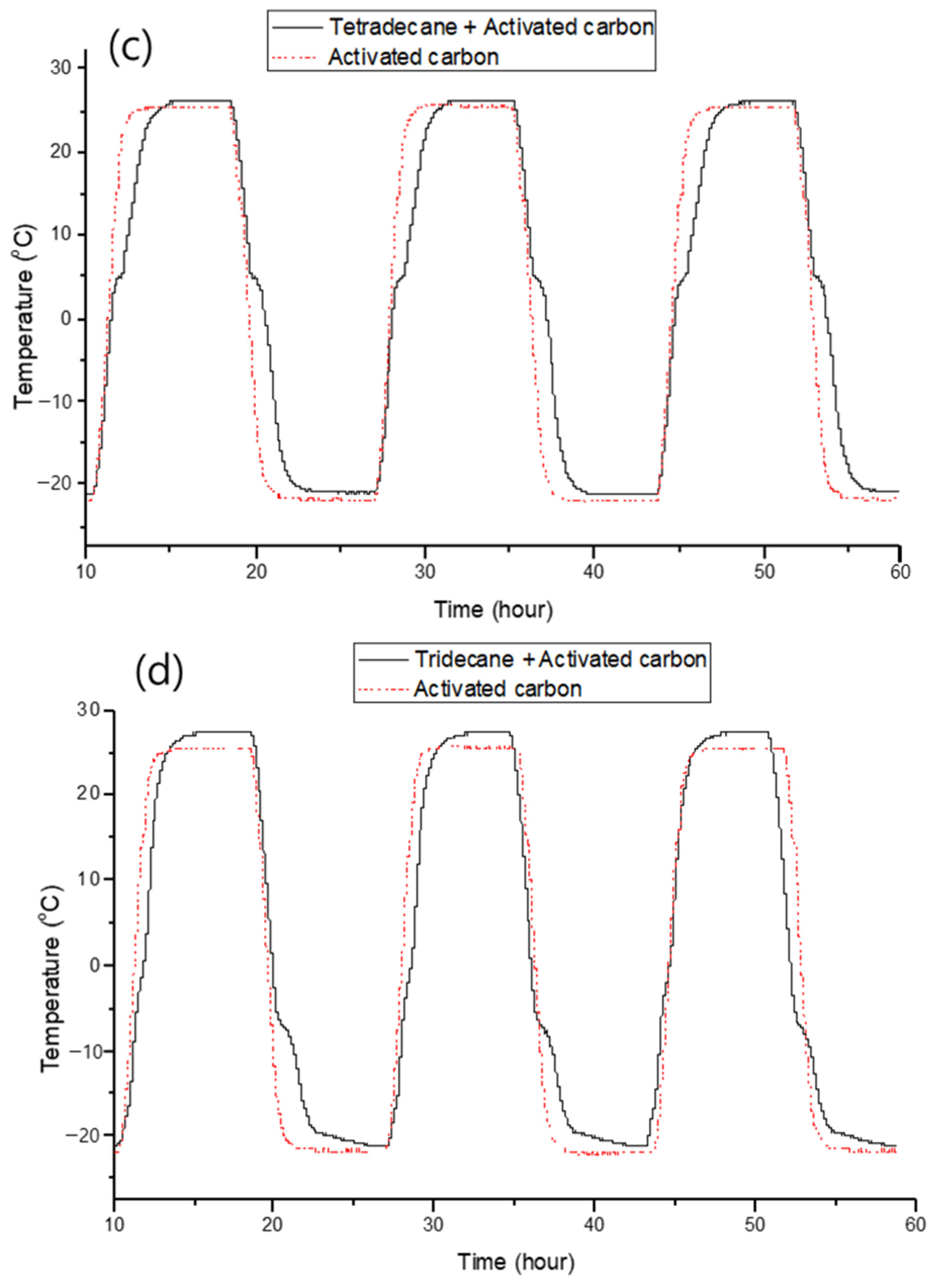



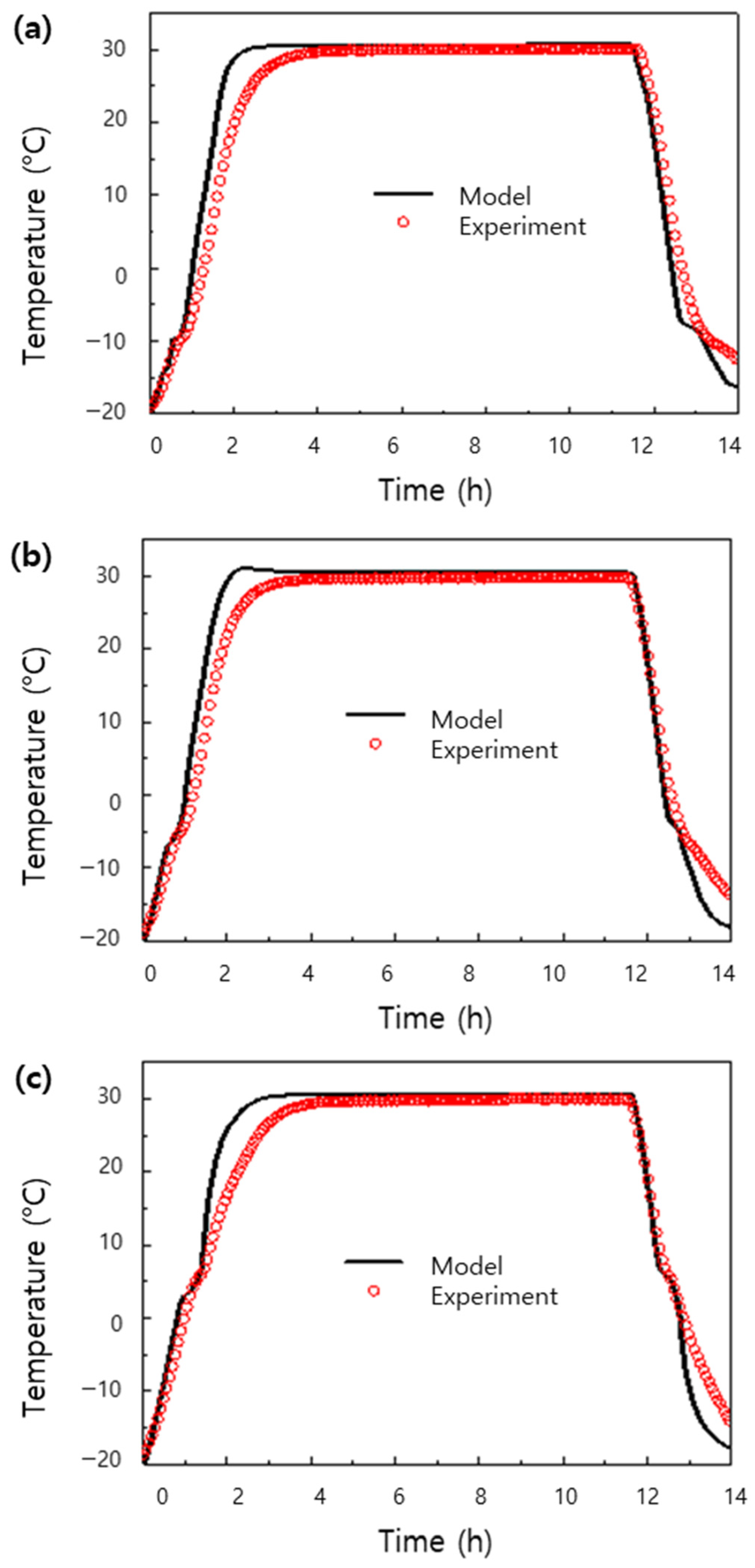
| Properties | Activated Carbon | |
|---|---|---|
| PW-AC (Powdered) | GW-AC (Granular) | |
| Mesh | 250–350 | 8–23 |
| Particle size | Approximately 40 μm | Approximately 1570 μm |
| BET surface area | 1039.1472 m2/g | 1060.1281 m2/g |
| Pore volume | 0.6131 cm3/g | 1.1242 cm3/g |
| Pore size | 23.6013 Å | 42.4180 Å |
| Phase Transient Temperature (°C) | Latent Heat (kJ/kg) | Specific Gravity | Classification for Usage | ||
|---|---|---|---|---|---|
| Organic Phase-Change Material | Dodecane | −10 | 349.3 | 0.78 | Low temp |
| Tridecane | −5 | 377.7 | 0.75 | Low temp | |
| Tetradecane | 5 | 124.9 | 0.76 | Low temp | |
| Pentadecane | 10 | 163 | 0.77 | Low temp | |
| PW-AC | GW-AC | ||||
|---|---|---|---|---|---|
| PW-AC | PW-AC-Embedded Tridecane | GW-AC | GW-AC-Embedded Tridecane | ||
| Weight change (g) | 50.23 | 52.42 | 50.10 | 51.64 | |
| BET analysis results | Surface area [m2/g] | 1039 | 20.4 | 1060 | 2.8 |
| Single point adsorption total pore volume of pores [cm3/g] | 0.61 | 0.07 | 1.12 | 0.004 | |
| Adsorption average pore width [Å] | 23.6013 | 155.5545 | 42.4180 | 57.0679 | |
| Sample | Thermal Storage Capacity Increase Ratio R QAC+PCM/QAC |
|---|---|
| AC + Dodecane | 3.67 |
| AC + Tridecane | 2.92 |
| AC + Tetradecane | 3.65 |
Disclaimer/Publisher’s Note: The statements, opinions and data contained in all publications are solely those of the individual author(s) and contributor(s) and not of MDPI and/or the editor(s). MDPI and/or the editor(s) disclaim responsibility for any injury to people or property resulting from any ideas, methods, instructions or products referred to in the content. |
© 2023 by the authors. Licensee MDPI, Basel, Switzerland. This article is an open access article distributed under the terms and conditions of the Creative Commons Attribution (CC BY) license (https://creativecommons.org/licenses/by/4.0/).
Share and Cite
Bae, J.; Kim, S.; Kim, K.; Baek, S. Impregnation of Activated Carbon with Organic Phase-Change Material. Materials 2024, 17, 67. https://doi.org/10.3390/ma17010067
Bae J, Kim S, Kim K, Baek S. Impregnation of Activated Carbon with Organic Phase-Change Material. Materials. 2024; 17(1):67. https://doi.org/10.3390/ma17010067
Chicago/Turabian StyleBae, Jiyeol, Suho Kim, Kwangsoo Kim, and Soyoung Baek. 2024. "Impregnation of Activated Carbon with Organic Phase-Change Material" Materials 17, no. 1: 67. https://doi.org/10.3390/ma17010067




